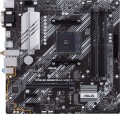Max. clock frequency
The maximum RAM clock speed supported by the motherboard. The actual clock frequency of the installed RAM modules should not exceed this indicator — otherwise, malfunctions are possible, and the capabilities of the “RAM” cannot be used to the fullest.
For modern PCs, a RAM frequency of
1500 – 2000 MHz or
less is considered very low,
2000 – 2500 MHz is modest,
2500 – 3000 MHz is average,
3000 – 3500 MHz is above average, and the most advanced boards can support frequencies of
3500 – 4000 MHz and even
more than 4000 MHz.
M.2 version
The version of the M.2 interface determines both the maximum data transfer rate and the supported devices that can be connected via physical M.2 connectors (see the corresponding paragraph).
The version of the M.2 interface in the specifications of motherboards is usually indicated by the number of connectors themselves and by the PCI-E revision provided for in each of them. For example, the entry “3x4.0” means three connectors capable of supporting PCI-E 4.0; and the designation “2x5.0, 1x4.0” means a trio of connectors, two of which support PCI-E 4.0, and another one supports PCI-E 5.0.
Audiochip
The model of the audio chip (a module for processing and outputting sound) installed on the motherboard. Data on the exact name of the sound chip will be useful when looking for detailed information about it.
Modern "motherboards" can be equipped with fairly advanced audio modules, with high sound quality and extensive features, which makes them suitable even for gaming and multimedia PCs (although professional audio work will still most likely require a separate sound card). Here are the most popular modern audio chips:
Realtek ALC887,
Realtek ALC892,
Realtek ALC1150,
Realtek ALC1200,
Realtek ALC1220,
Realtek ALC4050,
Realtek ALC4080,
Supreme FX.
Wi-Fi
Bluetooth
The motherboard has its own
Bluetooth module, which eliminates the need to purchase such an adapter separately. Bluetooth technology is used for direct wireless connection of a computer with other devices — mobile phones, players, tablets, laptops, wireless headphones, etc.; connectivity options include both file sharing and external device control. The Bluetooth connection range is up to 10 m (in later standards — up to 100 m), while the devices do not have to be in the line of sight. Different versions of Bluetooth (at the end of 2021, the latest of which is
Bluetooth v 5) are mutually compatible in terms of basic functionality and have all sorts of differences.
LAN controller
Model of the LAN controller installed in the motherboard.
The LAN controller provides data exchange between the card and the network port(s) of the computer. Accordingly, both general characteristics and individual features of the network functionality of the "motherboard" depend on the characteristics of this module: support for special technologies, connection quality in case of unstable communication, etc. Knowing the model of the LAN controller, you can find detailed data on it — including including practical reviews; this information is rarely needed by the average user, but it can be useful for online game enthusiasts and for some specific tasks.
Thus, the LAN controller model is specified mainly in cases where it is a rather advanced solution that is noticeably superior to standard models. Such solutions are currently produced mainly under the brands
Intel(middle level),
Realtek(relatively simple models),
Aquntia and
Killer(mostly advanced solutions).
CPU Fan 4-pin
A four-pin connector used to connect a processor cooling fan. The first contact in it corresponds to the black wire of the cooler — it is the "ground" or minus of the power supply. The second contact is the plus of the power supply (yellow or red cooler wire). The third one is involved in measuring the rotation speed of the impeller (green or yellow fan wire). The fourth pin, corresponding to the blue wire, receives control signals from the PWM controller to adjust the cooler rotation speed depending on the temperature of the processor.
CPU/Water Pump Fan 4-pin
A four-pin connector for connecting a water cooling pump fan. It can also be used to turn on an additional CPU cooler.

